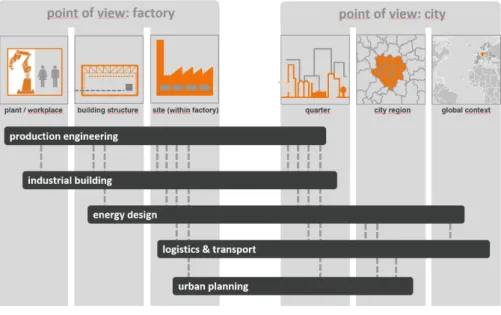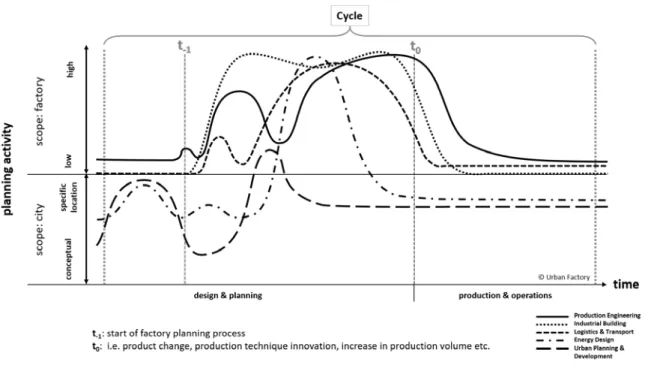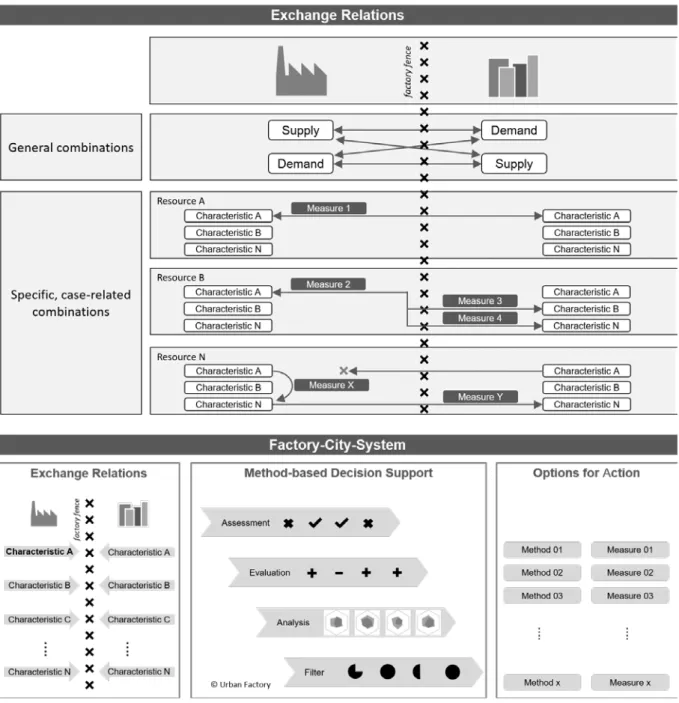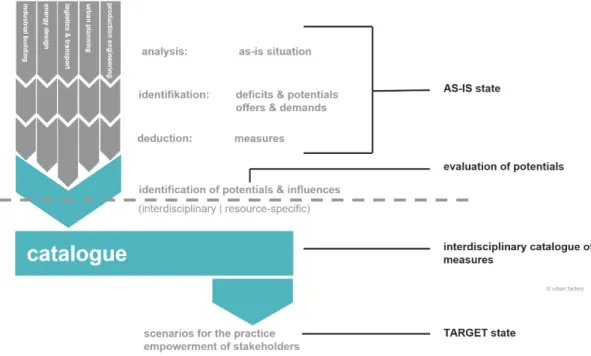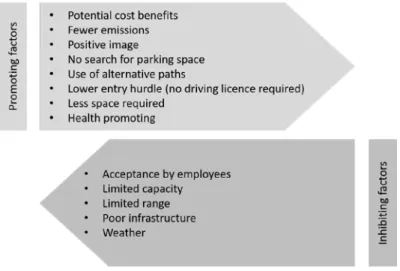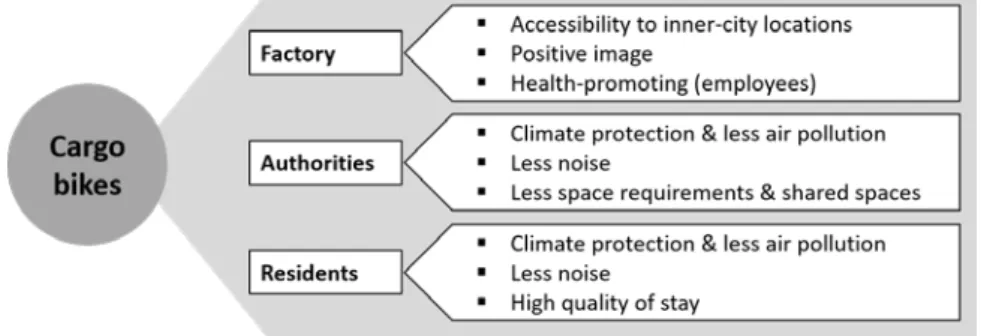Proceedings of 8th Transport Research Arena TRA 2020, April 27-30, 2020, Helsinki, Finland
Urban Factories – Establishing resource-efficiency in production logistics systems in cities
F. Kreuz
a*, M. Bucherer
b, M.Juraschek
c, U.Clausen
aa Institute of Transport Logistics (ITL), TU Dortmund University, Leonhard-Euler-Str. 2, 44227 Dortmund, Germany
b Institute of Industrial Building and Construction Design (IIKE), Technische Universität Braunschweig, Pockelsstraße 3, 38106 Braunschweig Germany
c Chair of Sustainable Manufacturing and Life Cycle Engineering, Institute of Machine Tools and Production Technology (IWF), Technische Universität Braunschweig, Langer Kamp 19B, 38106 Braunschweig, Germany
Abstract
Cities are a hotspot for resource consumption and related impacts. This is induced, among others, by transportation, production and the use of products and services. Industrial production is commonly associated with negative impacts, e.g. on the environment or traffic. Through positive integration of production sites into urban surroundings, negative impacts can be eliminated, and even positive impacts achieved. To reach a higher degree of integration of different utilizations in cities, resource-efficiency, new conceptual approaches are required for urban factories, city authorities and further stakeholders. For this purpose, a methodology has been developed that describes the planning processes of the involved disciplines and their interdependencies concerning content and timing. Subsequently, an analysis of Urban Factories within a reference framework called the factory-city-system and its key resources is carried out in an exemplary case study. Measures to enhance resource-efficiency are thus identified, exemplarily described and examined regarding their potential to raise resource-efficiency.
Keywords: Urban Factories; Urban Logistics; Sustainable Development, Resource-Efficiency
* Tel.: +49 (0)231 755 7816;
E-mail address: kreuz@itl.tu-dortmund.de
1 1. Introduction
Cities are the most vibrant and dynamic places in human civilization. Today, already the majority of the world’s population is living in urban areas. This figure is prospected to reach more than 70 % until the year 2050 (United Nations 2014). There seems to be no specific, single reason responsible for the peculiar attractiveness of cities, but rather the mixture of different functional elements and their diversity coming together in close proximity to each other. This density enables the generation of new products, new ways of value creation and fosters innovation (Carlino et al. 2007; Jacobs 1969). The relationship between the factory and its city surroundings is defined by a common spatial interface that can act as a barrier for interaction (Juraschek et al. 2016). This barrier is on the one hand naturally overcome by logistics for supply, distribution and disposal. On the other hand it dampens the impacts of other exchange flows related e.g to safety concerns or emissions. While the spatial layers of a city can be analysed with structural models from the field of urban planning (e.g. Reicher 2014) and factories with their spatial and functional structure are also well described in literature from an external and internal perspective (e.g.
Wiendahl et al. 2014), an integrated, holistic consideration of both systems is still seldom undertaken. However, in the emerging field of urban production it is increasingly recognized (e.g. Läpple 2013; Verein Deutscher Ingenieure 2015).
Empiric evidence shows that overcoming the spatial and functional separation can lead to efficiency gains and cost saving for urban companies, for instance in the case of (urban) industrial symbiosis (van Berkel et al. 2009).
Interviews with companies producing in urban areas further suggest that there can be benefits for Urban Factories, yet also challenges arising from their locations, depending on the characteristics of the production system and the urban quarter surrounding them (Juraschek et al. 2018). In order to raise the potentials of urban production, the spatial and functional separation involving multiple disciplines, such as production, spatial planning, energy supply as well as transport and logistics, needs to be overcome. In the following, the discipline of logistics & transport will serve as an example to explain the methodology of the proposed holistic planning and improvement process.
1.1. Interdisciplinary perspectives on Urban Factories
In order to identify and analyse the interdependencies of cities and their factories with the aim of finding suitable measures for resource-efficiency, it is necessary to take an interdisciplinary approach. This initially requires the identification of the relevant disciplines in context of Urban Factories, which can vary regarding specific circumstances. Generally, they include the disciplines Production Engineering, Industrial Building &
Architecture, Logistics & Transport, Energy Design and Urban Planning.
The disciplines involved are responsible to create the framework and prosperous conditions for the production of
goods in urban space and at the same time to create and maintain cities and neighbourhoods worth living for the urban society. However, these disciplines themselves operate under different conditions and with different objectives, thus adopting different perspectives. Fig. 1 shows the relevant disciplines and illustrates their different perspectives in terms of spatial and content focus. While Production Engineering and Industrial Building act
Fig. 1: perspectives of involved disciplines
2 locally and accordingly focus on economic aspects, Energy Design and Urban Planning mainly consider administrative aspects focusing on regional or even national levels. Logistics & Transport occupies a mesoscopic position. While the logistics company acts as a service provider for the factory and in its own interest, the performed services, as for instance supply and disposal of materials from the production system, involves a more or less complex supply chain or supply network comprising several other urban sub-systems.
In addition, for the involved disciplines a temporal offset in the planning can be determined. Fig. 2 shows the different planning phases and activity levels of the individual disciplines. An in-depth analysis of the spatial, temporal and content-related orientation and perspective of the planning and operations of Urban Factories is presented in Kreuz et al. (2019).
Against this background of different perspectives, interests and dependencies, it becomes apparent that a holistic approach is required to enable an interdisciplinary examination of Urban Factories. Under the objective of increasing resource efficiency, this approach must comprise a common set of resources which are embedded into a reference framework for operationalization.
1.2. Establishing the factory-city-system
For the consideration of the various material and immaterial interactions between city and factory the resources of Urban Factories and its surrounding city are fundamental. An Urban Factory can be understood only in its functional and spatial connection with the surrounding city and the history of the location. As shown, an interdisciplinary approach is indispensable for the integration of factories in the urban fabric as a positive urban building block. Within this framework, eight key resources are considered as central fields of action. The definition of these eight resources is based on the following terminology in the context of urban production.
• An Urban Factory is defined by Juraschek et al. (2016) as a factory situated in an urban environment that acts as a multifunctional settlement area with complementary uses for production entities in close proximity. In general, two motivations can be identified for research on Urban Factories (Juraschek et al.
2018a): (i) reducing or eliminating negative impacts and (ii) enabling the potentials for cities and factories.
• A resource is a means to perform an action or to allow a process to proceed. A resource can be a material or immaterial good. Any resource is tied to time and capital. (Juraschek et al. 2018b)
• The exchange relationship is, in general, defined as the relationship between the material or immaterial transfer of resources and the effects resulting from the use of resources. In terms of resource-efficient Urban Factories, exchange relationships have effects beyond the factory fence.
Fig. 2: Planning activities of involved disciplines (Kreuz et al. 2019)
3
• All resources and exchange relationships take place within a reference framework, which encompasses spatial and functional system boundaries and includes the time and capital framework for action. This reference framework is called the factory-city-system.
• Efficiency describes the goal of achieving the greatest possible benefit with the least possible effort.
Resource efficiency means the utilization of resources in the sense that they have the greatest possible benefit.
• The use of a resource is considered to be sustainable if the rate of use is not greater than the rate of regeneration of a resource or the carrying capacity of the use in the providing system over time.
The systematic approach towards a holistic understanding of Urban Factories and the underlying methodology is based on eight key resources shared by cities and their factories, described briefly below. All activities in the Urban Factory system influence the shared resources positively or negatively. These resources therefore form the basis to analyse factory-city-systems and are key to identify and implement suitable measures in order to establish resource-efficiency. For an in-depth derivation and description of the resources of the factory-city-system refer to Juraschek et al. (2018).
Energy is required for the execution of all operations and actions and thus represents a fundamental resource for all processes. Energy can occur and be used in various forms and can also be converted from one form to another.
The efficient use of the resource Energy by Urban Factories aims at the lowest possible use of energy for desired, energy-demanding activities, also with regard to the factory-city-system.
Materials includes all material, physically existing matter and things. These are in particular all material substances that are present in the factory-city-system. For the production of physical products, materials are indispensable as input. Due to concentration of consumption, output materials also accumulate in the factory-city-system. The efficient use of the resource materials is subject to a two-fold objective. On the one hand, the specific material requirement or input must be reduced while on the other hand, materials with the most resource-efficient extraction possible or sources with the least possible impact should be used. Within the factory-city-system,circular concepts and cascading use of materials between the individual system elements can support these goals.
In the factory-city-system, the Human being is understood as a resource, as long as theiractions are connected with urban production. This includes, among other things, the workforce employed, the generation of innovation or the consumption of the goods produced. In addition to this, the resource Human in the sense of neighbourhood, acceptance, need for protection and well-being is also a significant factor for the ability to integrate production into urban space. For further operationalization, the resource Human can be subdivided into different stakeholders of the factory-city-system. In the context of Urban Factories, there are a large number of stakeholders who in aggregation fall into the categories of city authorities, factory and other production businesses and residents resp.
the urban society.
On the one hand, the resource Space refers to the available ground surface that can be used in various ways. In addition, this view includes the uppermost layer of the earth, which in its natural form fulfils multiple environmental functions. On the other hand, the resource describes the availability of three-dimensional space for objects and activities. In factory-city-systems, there are often conflicting objectives between the intended types of use. The goal of the efficient use of the resource Space is the full exploitation of the potentials, for example through multiple uses and a reasonable balance of interests.
Knowledge is an intangible resource and consists of linked information. It is an indispensable resource to carry out a desired action or to execute processes. Knowledge is also decisive for the selection of potential action alternatives. Knowledge is only stored in humans. As a resource in the context of the factory-city-system, the purposeful use of knowledge allows solving problems and is a prerequisite for innovation.
The resource Justice enables the socially guaranteed enforcement of claims and allows activities to be carried out within defined action frameworks. Justice consists of generally valid rules of conduct, and therefore is part of the culture of a society. For the factory-city-system, through the implicit and explicit use of the resource Justice, the possible framework of action for Urban Factories is defined.
Mobility enables the spatial transformation of material and immaterial objects through movement. Both, material objects, such as people or goods, and immaterial objects, such as energy or information, require infrastructure to be transported. In the factory-city-system there is a high, spatially concentrated demand for mobility. An efficient
4 use of the resource mobility aims at the lowest possible effort for necessary spatial movement.
The resource Image describes the effects of entities and objects on human consciousness and the related associations. Image is thus an immaterial, emotional resource and indirectly influences actions. In connection with the shape of the entities and objects, Image creates the identity of e.g. products, buildings, companies or persons.
By influencing actions and effects, image is a usable resource in the factory-city-system.
2. Establishing resource-efficiency in factory-city-systems
The challenge remains to identify suitable measures and actions for specific Urban Factory cases. For this purpose, the factory-city-system can be implemented as supporting tool based on the resources of the Urban Factory and the three-level model. This allows support of a factory analysis and improvement of resource efficiency from a holistic point of view. As illustrated in Fig. 3, the factory-city-system is shaped by its exchange relations.
These exchange relations, which are based on the resources of the factory-city-system, are core to analyse factory- city-systems and to apply measures to enhance resource-efficiency. In order to do so, a four-step approach is proposed as illustrated in Fig. 4. For a more detailed description of the applied approach, refer to Bucherer et al.
Fig. 3: Exchange relations of the factory-city-system
5 (2019b).
• Step 1: As-is analysis
Analysing a factory-city-system starts by examining the actual state of a factory and its surroundings. The individual disciplines first compile information independently based on general or discipline-specific methods and tools. This as-is analysis can be carried out on different system levels (e.g. workplace, building, site, quarter or city). The aim is to identify the deficits and potentials within a specific factory-city-system as well as the stakeholders, which are actively or passively involved in the development of the factory or the city. Based on this, it is possible to identify potential offers (e.g. excess waste heat) and demands (e.g heating) within the factory-city-system.
• Step 2: Evaluation of potentials
After analysing the existing potential offers and demands potential exchange relations between a factory and the urban surroundings are examined. For this purpose, all identified potential relations are assessed regarding their possible connection with any other relation. This requires a comprehensive, interdisciplinary comparison of the results of the as-is analysis and identifies possible potentials for optimising the factories or neighbourhoods. The individual connection of offers and demands sets the framework for possible measures to enhance resource-efficiency.
• Step 3: Measures
Step 3 is a compilation of all potentially suitable measures for the identified exchange relations. In general, measures are derived from literature reviews, best-practice analysis as well as surveys and expert interviews.
Relying on a filtering and rating algorithm of measures, a pre-structured collection of suitable methods and measures can be generated. This also ensures an interdisciplinary evaluation of the factory-city-system, enabling a more resource-efficient operation of Urban Factories and their urban surroundings.
• Step 4: Target state
Based on the possible measures identified for the specific case, this step identifies concrete practical options for action for an improvement along the objectives of the key stakeholders. The measures can be implemented according to various scenarios - short term if immediate action is required or long term as a future scenario for the further development of the company or neighbourhood.
2.1. Identifying measures to enhance resource-efficiency in transport & logistics
For the measures of the discipline logistics & transport in urban areas different descriptive approaches are proposed (e.g. Russo and Comi (2010); Muñuzuri et al. (2005)). Based on Dahmen et al. (2017) the measures can be grouped
Fig. 4: Four-step analysis of Urban Factories
6 into the following categories:
• regulative,
• pricing,
• infrastructural & urban planning,
• technical innovation,
• information & communication and,
• organisational & operational measures.
Regulative measures change the operative framework conditions under which transport is carried out in urban areas. These include, for example, the definition of exhaust gas limit values as well as the definition of loading zones and access restrictions for certain vehicles.
Price policy measures change the financial framework conditions under which transport is carried out in urban areas and therefore intervene in the pricing of the transport market. These measures either reward desired behaviour or punish unwanted behaviour. Examples of such measures are (energy) taxes, congestion charging or (penalty) charges.
Infrastructural & urban planning measures regulate land use and should provide an adapted or sufficient (transport) infrastructure. Such measures thus directly influence the extent of infrastructural resources available for transport. Infrastructural & urban planning measures have a direct stakeholder reference to the city authorities or the municipality, which implements them as sovereign tasks. Examples are land use plans or the dimensioning and extension of traffic facilities such as roads or crossroads.
Technical innovation measures relate to the further technical development of transport and, where appropriate, handling and storage equipment used. Prominent examples are alternative drives or new vehicle types that are better adapted to the transport purpose and traffic in urban areas. Far-reaching technical innovations can also lead to the development of new logistics concepts. One example of this is the conversion of an inland waterway vessel that serves as a mobile depot for parcel shipments (Dizian et al. 2014).
On the one hand, information & communication technology measures are intended to raise general awareness of negative effects of traffic and, on the other hand, to help road users or planners in making more ecological or efficient decisions through the availability of information and communication options. Examples are traffic signalling systems such as guidance systems or traffic jam indicators and forecasts.
Organisational & operational measures intervene in operational processes or change the underlying transport concept in order to increase efficiency potentials in the own organisation. As a rule, these measures originate from companies that implement them independently or in cooperation with other companies. This category of measures has strong references to city logistics concepts. Examples are delivery cooperation between transport service providers, ordering cooperation between recipients or changes to the vehicle fleet up to the use of alternative vehicle types such as cargo bikes.
Through literature research (including Holgiun-Veras et al. (2014), Browne et al. (2012), Munuzuri et al. (2012), Muñuzuri et al. (2005), Klein-Vielhauer (2001), Taniguchi und Heijden (2000)), expert interviews and a survey at a model site of an Urban Factory, in total 120 measures (Bucherer et al. 2019c), of which 37 refer to transport &
logistics, were identified that could potentially increase the resource efficiency of factory-city-systems.
2.2. Applying measures to enhance resource-efficiency in transport & logistics
In order to prove the applicability and influence of measures in transport & logistics, a case study with cargo bikes was conducted, which applied the during analysis identified measure using cargo bikes for urban distribution.
This case study comprised two electric cargo bikes, which were supposed to compete with a car, which was regularly used for distribution in the city. The cargo bike was used to transport goods for home delivery (e.g.
groceries, medicine, etc.). Table 1 summarizes the basic data of the model test.
Table 1. Operation data of the cargo bike case study
Cargo bike Car
Operating days 30 30
Total number of shipments delivered 97 471
Share of shipments delivered 17% 83%
Avg. number of shipments per day 2.84 13.16
Avg. distance travelled per tour [km] 13.41 60.72
7 In addition, the costs and CO2 emissions of the cargo bike and car were determined for the two types vehicles used in the case study. Based on an annual mileage of 10,000 km, the total costs for the cargo bike (excluding personnel costs) are € 0.08 per km, while the costs for the passenger car are € 0.32 per km. The cargo bike therefore cuts operating costs by 75%. However, personnel costs have not been taken into account, which usually account for the majority of distribution costs. Table 2 gives an overview of the comparative calculation for one year.
Table 2. Costs of cargo bike and car
Cargo bike Car
Purchasing costs [€] 3,690 € 10,000 €
Operating life [years] 5 5
Value after operating life [€] 554 3,000
Operating days per year 200 200
Daily distance travelled [km] 50 50
Fuel costs per 100 km [€] 0.23 6.27
Maintenance and repair per year [€] 120 500
Insurance & taxes per year [€] 0 700
Total costs per km [€] 0.08 0.32
The CO2 emissions were calculated based on the electricity and fuel consumption of the vehicles. The electric cargo bike emitted 5.384 g CO2 per km. In comparison, the car used, with a consumption of 8 litres of fuel per 100 km, caused 200 g CO2 per km.
In addition to the calculations on the data collected during the case study, interviews were conducted with the users of the cargo bikes. From these, further findings were obtained on factors inhibiting or promoting the use of cargo bikes in distribution. Fig. 5 summarizes the findings of these interviews.
Most apparent promoting factor is the potentially lower costs due to the use of (electric) cargo bikes depending on the application. In addition, the use of cargo bikes does not cause local emissions and less global emissions per kilometre. Additionally, new job opportunities arise, as no driving licence is required. Also, cycling is health- promoting. Cargo bikes are also (often times) allowed to enter pedestrian zones, which makes them more flexible in operations as there is no need to search for parking space. A lack of employee acceptance was identified as a relevant, inhibiting factor making it necessary to find a solution to motivate the employees to use bikes for distribution. Furthermore, the shorter range and the capacity of cargo bikes can be inhibiting factors. However, the model experiment has shown that in urban transport the range is hardly an obstacle and the limited capacity is only of secondary importance. Despite the lower capacity, it is possible, depending on the shipment structure, to bundle orders and deliver them within a tour. Another frequently mentioned obstacle is the lack of or poorly developed bicycle infrastructure. In addition, the parking facilities at the urban distribution or production site can pose a particular challenge for smaller, inner-city companies.
Fig. 5: Promoting and inhibiting factors for the use of cargo bikes
8 In summary, it can be stated that cargo bikes will not completely replace cars in urban distribution. It is possible, however, to put cargo bikes to a profitable use in urban traffic. In order to do so the following aspects should be considered:
• The size of shipments should not exceed the loading equipment.
• The distribution radius should be restricted to inner-city areas. Otherwise, an additional battery charge must be carried along and possibly longer driving times must be accepted.
• The shipment structure should mainly consist of small shipments, so that cargo bikes are able to achieve bundling effects.
• Employee acceptance can be the decisive criterion for the establishment of electric cargo bikes.
2.3. Evaluating measures to enhance resource-efficiency in transport & logistics
Based on the results of the case study, the potential of the use of cargo bikes as a measure to increase resource efficiency in the factory-city-system can be estimated. To this end, the positive or negative contribution of the measure for the affected resources is described. Additionally, the measure can be evaluated against the (general) objectives of the identified key stakeholders in order to support or impede a positive influence for all stakeholders and the overall system. The evaluation is based on the assumption that the use of cargo bikes is economically reasonable.
For the resource Energy it can be stated that the use of cargo bikes requires less fossil energy than the use of cars for performing the same function. In addition, it does not cause any local and less global air pollutant emissions.
For the resource Human it must be noted that not all employees have a positive attitude towards the use of cargo bikes but that the use of cargo bikes has a health-promoting effect, which can increase the overall well-being of the employees. In addition, the use of cargo bikes generates less noise. The measure therefore positively affects the efficiency of the resources Energy and Human beyond the factory fence as an exchange relation because the distribution of the factory products emits less air pollutants and noise to the surrounding city.
Cargo bikes need less Space and less infrastructure for their operations and are generally more compatible with other uses (e.g. green spaces), so that a combined use of space can be achieved, both of which positively affects the efficiency of the resource space. In terms of positive effects beyond the factory fence, the use of cargo bikes consumes less city space for distribution. For the resource Mobility, the use of cargo bikes offers better accessibility to inner-city locations, less time spent searching for parking spaces and fewer entry restrictions. Finally, the use of cargo bikes can have a positive impact on the company's Image, a resource which can only be created across the factory fence and thus always acts as an exchange relation of the Factory-City-System. With respect to other disciplines involved in Urban Factories, the use of cargo bikes can have effects on the production system and its operations. Differences in shipment size, flexibility and frequency can on the one hand limit the production capacity but on the other hand enable new business models, as for instance the manufacturing and transportation of small, personalized lot sizes. The factory building and infrastructure can also face changed requirements resulting in new designs of the construction, layout and the material flow to and from the logistics interface or as a result of the afore mentioned impacts from changes in the discipline production engineering.
Fig. 6 summarizes the evaluation of the use of cargo bikes, regarding the (general) objectives of the stakeholders.
Fig. 6: Evaluation of the use of cargo bikes – stakeholder perspective
9 3. Conclusion and outlook
When taking an integrated viewpoint by including other disciplines, there is a corresponding challenge to avoid conflicts of objectives. Each discipline undertakes great efforts to achieve an optimum within its own system and, in analogy to the mathematical field of analysis, each discipline can reach a local maximum. Considering the entire system context, however, the goal must be to reach a global maximum. But a holistic view of Urban Factories has so far been largely neglected. A clearly defined set of shared values and an encompassing reference framework are essential for the mutual understanding between disciplines and as a basis for the development of a common planning system. The presented analysis of the Resources of the Urban Factory and interactions of the Factory- City-System enable this holistic approach.
Due to the different scopes, perspectives and the complex and dynamic interactions, the identification and description of all options for action of the factory-city-system remains challenging. Nevertheless, the extensive creation of common grounds proves to be advantageous, as it already constitutes a first step towards interdisciplinary cooperation. With this approach, the manifold, already existing measures originating from individual disciplines or stakeholders can be re-evaluated for their suitability for overall resource efficiency improvements.
Acknowledgements
The authors gratefully acknowledge the funding by the Federal Ministry for Economic Affairs and Energy (BMWi) within the 6th Federal Government's Energy Research Program (EnEff:Stadt, Grant 03ET1311A-D).
References
Bucherer M., Clausen, U., Herrmann, C., Hoffschröer, H., Juraschek, M., Kreuz, F. et al. (2019a): Urban Factory – Entwicklung ressourceneffizienter Fabriken in der Stadt – Abschlussbericht Teil 1: Theoretische Grundlagen & Hypothesen. Braunschweig. DOI:
10.24355/dbbs.084-201909121223-0.
Bucherer M., Clausen, U., Herrmann, C., Hoffschröer, H., Juraschek, M., Kreuz, F. et al. (2019b): Urban Factory – Entwicklung ressourceneffizienter Fabriken in der Stadt – Abschlussbericht Teil 2: Empirische Untersuchungen: Methoden, Ergebnisse, Schlussbetrachtung. Braunschweig. DOI: 10.24355/dbbs.084-201909121224-0.
Bucherer M., Clausen, U., Herrmann, C., Hoffschröer, H., Juraschek, M., Kreuz, F. et al. (2019c): Urban Factory – Entwicklung ressourceneffizienter Fabriken in der Stadt – Abschlussbericht Teil 4: Maßnahmenkatalog zur Anpassung von urbanen Fabriken.
Braunschweig. DOI: 10.24355/dbbs.084-201909121226-0.
Browne, M., Allen, J., Nemoto, T., Patier, D., Visser, J. (2012). Reducing Social and Environmental Impacts of Urban Freight Transport: A Review of Some Major Cities. In: Procedia - Social and Behavioral Sciences 39, 19–33.
Carlino, G. A., Chatterjee, S., & Hunt, R. M. (2007). Urban density and the rate of invention. Journal of Urban Economics, 61(3), 389–419.
Dahmen, B., Thaller, C., Leerkamp, B., Clausen, U. (2017). Modelling the impacts of urban transport measures by linking an urban commercial transport demand model with System Dynamics. In: Transportation Research Procedia.
Dizian, D., Taniguchi, E., Dablanc, L. (2014). Urban Logistics by Rail and Waterways in France and Japan. 8th Conference on City Logistics.
In: Procedia - Social and Behavioral Sciences (125).
Holguín-Veras, J., Wang, C., Browne, M., Hodge, S. D., Wojtowicz, J. (2014). The New York City Off-hour Delivery Project: Lessons for City Logistics. In: Procedia - Social and Behavioral Sciences 125, 36–48.
Jacobs, J. (1969). The Economy of Cities. New York: Random House.
Juraschek, M., Becht, E. J., Büth, L., Thiede, S., Kara, S., & Herrmann, C. (2018a). Life Cycle Oriented Industrial Value Creation in Cities.
Procedia CIRP, 69(May), 94–99.
Juraschek, M., Kreuz, F., Bucherer, M., Sonntag, R., Schnabel, F., Hoffschröer, H., Vossen. B., Herrmann, C. (2018b). Die Ressourcen der urbanen Fabrik: Definitionen und Erläuterungen aus dem Forschungsprojekt Urban Factory.
Juraschek, M., Vossen, B., Hoffschröer, H., Reicher, C., & Herrmann, C. (2016). Urban Factories: Ecotones as Analogy for Sustainable Value Creation in Cities. 1. interdisziplinäre Konferenz zur Zukunft der Wertschöpfung. Hamburg. 135–145.
Klein-Vielhauer, S. (2001). Neue Konzepte für den Wirtschaftsverkehr in Ballungsräumen. Ein Werkstattbericht über Bemühungen in Praxis und Wissenschaft. Karlsruhe: Forschungszentrum Karlsruhe GmbH.
Kreuz, F., Juraschek, M., Bucherer, M., Söfker-Rieniets, A., Spengler, A., Clausen, U., Herrmann, C. (2019). Urban Factories – Interdisciplinary Perspectives on Resource Efficiency. In: Elbert, R., Christian, F., Boltze, M., Pfohl, H.-C. (eds.): Urban Freight Transportation Systems. Amsterdam, Oxford, Cambridge: ELSEVIER, 41–52.
Läpple, D. (2013). Produktion zurück in die Stadt? In M. Kronauer & W. Siebel (Hrsg.), Polarisierte Städte. Soziale Ungleichheit als Herausforderung für die Stadtpolitik, 129–150).
Muñuzuri, J., Cortés, P., Guadix, J., Onieva, L. (2012). City logistics in Spain: Why it might never work. In: Cities 29 (2), 133–141.
Muñuzuri, J., Larrañeta, J., Onieva, L., Cortés, P. (2005). Solutions applicable by local administrations for urban logistics improvement. In:
Cities 22 (1), 15–28.
Reicher, C. (2014). Städtebauliches Entwerfen. Wiesbaden: Springer Vieweg.
United Nations. (2014). Department of Economic and Social Affairs. World Urbanization Prospects. World Urbanization Prospects. 2014 Revision. Highlights, 32.
Russo, F., Comi, A. (2010). A classification of city logistics measures and connected impacts. In: Procedia - Social and Behavioral Sciences 2 (3), 6355–6365.
10 Taniguchi, E., van der Heijden, R. (2000). An evaluation methodology for city logistics. In: Transport Reviews 20 (1), 65–90.
van Berkel, R., Fujita, T., Hashimoto, S., & Fujii, M. (2009). Quantitative Assessment of Urban and Industrial Symbiosis in Kawasaki, Japan.
Environmental Science & Technology, 43(5), 1271–1281.
Verein Deutscher Ingenieure e.V. (2015). Handlungsfelder VDI-Initiative Stadt:Denken Bausteine für die Stadt der Zukunft.
Wiendahl, H.-P., Reichardt, J., Nyhuis, P. (2014). Handbuch Fabrikplanung. Konzept, Gestaltung und Umsetzung wandlungsfähiger Produktiosstätten. München: Carl Hanser Verlag.
